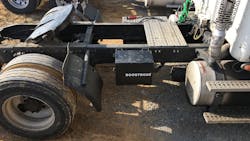Company: A&J Delivery Inc., Jonesboro, AR
Operation: Less-than-truckload freight contract carrier with trucks running line-haul operations as well as deliveries within cities such as Memphis, TN.
Challenge: In A&J Delivery's experience, semi-trucks with 2007 and later emission systems and controls have created too many maintenance costs and associated downtime, according to owner William (Bill) Reed III. For this small fleet of 17 circa 2006 Freightliner Columbia Class 8 trucks, older technology has proven more sustainable and reliable.
But that doesn't change the need to maximize fuel efficiency, and in terms of maintenance, it means that wear-and-tear engine repair costs can add up. And while the company deals mostly with mild winters where it operates, cold-weather starts can still be a problem. Older trucks, while they may be less complicated, can be finicky and require a special touch.
"With a lot of trucks on the road, there's a big puff of black smoke every time they change a gear. Or you'll start up a truck and smoke just rolls out of it," said Reed, speaking about soot buildup in diesel engines.
"When you get into a semi that's been sitting even just overnight, you go to start it and it cranks up just billowing white smoke almost like a nuclear power plant," he added. "Or a lot of times when it's cold, they don't even want to start up."
Solution: A&J Delivery got a chance to try out two BoostBox H2 add-on units on its trucks, and has now been using the technology for more than a year. The product supplies hydrogen to the engine whenever it's running to enrich the air-fuel mix, promising a number of benefits, and can accommodate engines with start-stop functionality.
After testing, real-world use and refinement since BoostBox H2's launch in 2014, this is the seventh-generation product that's now being released to the mass market. The system uses a type of fuel cell technology, only "run in reverse," noted David Rechberger, CEO and CTO of BoostBox H2, which is also the company's d.b.a. While fuel cells typically use hydrogen to produce electricity and water, the BoostBox H2 uses water and electricity to make hydrogen and oxygen.
The oxygen is simply vented, but hydrogen is fed into the truck's air intake, acting as a catalyst so diesel fuel burns more quickly and completely, according to Rechberger. "We provide fuel savings by steepening—but not increasing—the torque curve. You get the same amount of work out of the engine at lower RPM," he told Fleet Owner.
A&J Delivery's Reed said he's found that the BoostBox makes the truck's engine run "extremely clean." "There's almost no exhaust. You can take that top cap off the engine and it looks almost brand-new," he said. "The other thing with the BoostBox, because of the hydrogen, is that as soon as you turn the key, it doesn't matter if it's 20 below zero. That dude fires right on up. It's awesome."
Relating to maintenance and ongoing usage, "you're removing those carbon particulates that form soot, contaminate your lubricating systems, create wear surfaces—those things that generate the need for maintenance on heads, pistons, valves, injectors and so on," Rechberger claimed. "You significantly increase your engine life, and your maintenance schedules [such as for filters] can change, although we leave that up to the fleet. It can actually clean up an older engine."
The BoostBox H2 is 18x17x17 in., about the size of a standard truck box, and it's usually mounted behind the cab or on the side rail. The system weighs about 50 lbs. when filled with the distilled water it needs to do its job. It uses about 1 gal. every 2,000 miles, and can heat and cool the water as needed.
Reed said he's noticed fuel efficiency gains between 7% and 10% using the BoostBox H2 on his trucks. "That's always a big plus, because fuel, driver pay and maintenance are your biggest expenses," he noted. "In trucking, every penny makes a difference."
Would he consider adding more of the BoostBox H2 units to his trucks? "Most definitely," Reed responded to that question. "I would recommend them to anybody."
About the Author
Aaron Marsh
Aaron Marsh is a former senior editor of FleetOwner, who wrote for the publication from 2015 to 2019.
